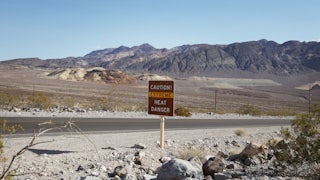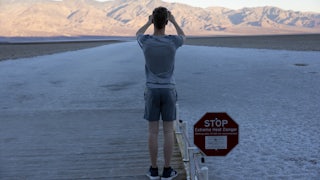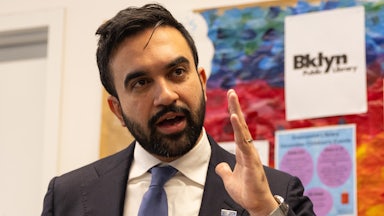It is really, really hot in many parts of the United States, and only getting hotter. Some 94 million people across the U.S. have been under heat advisories in the past week thanks to a high-pressure weather system known as a heat dome. This year could end up being the warmest year on record, topping a record broken only last year. Just about anywhere you go in the Northern Hemisphere is scorching. Record temperatures in Asia and Europe are estimated to have killed hundreds, and potentially thousands, per Reuters. More than 1,000 pilgrims taking part in this year’s Hajj, to Mecca, Saudi Arabia, have succumbed to the heat as highs soared to 125 degrees at the city’s Grand Mosque. Highs in Delhi, India, have breached 104 degrees since May, peaking at 122 degrees; more than 100 people are believed to have died of heat-related causes across the country in recent months. Here in the world’s wealthiest country, protection from the heat is far from guaranteed, either—especially if you happen to be among the 44 million households that rent their homes.
Tenants have different protections depending on the type of housing they live in and where it is. When it comes to temperatures, landlords are mostly required by state or local regulations to keep units from dropping below a certain temperature in the winter. Making sure they actually do that is harder, of course. New York City, for instance, has some of the country’s strongest measures for enforcing these kinds of habitability rules. Nonetheless, the building where I used to live in Crown Heights—part of the Crown Heights Tenants Union—had to go on rent strike and take our landlords to court for turning off the heat for two winters in a row. The shut-off was their attempt to oust longtime residents in rent-regulated apartments so owners could gut-renovate them and bring in tenants who’d pay double or triple the price.
There are fewer protections for keeping renters’ homes cool—or to prevent landlords from trying to force them out by making those homes excruciatingly hot. Certain historically hotter municipalities have established cooling standards and maximum temperature ordinances, in some cases building on state requirements. They’re getting warmer. And as places where extreme temperatures have been relatively rare experience longer, more frequent, and hotter heat waves as a result of the climate crisis too, already-lax requirements for landlords to keep tenants safe in their homes are being pushed to the limit.
Jovana Morales, the Fresno-based housing policy director of the Leadership Council for Justice and Accountability, worked to pass a bill through the California legislature that would have required rental units be able to maintain safe indoor air temperatures. That failed to advance in the Senate in 2022, but elements of the measures were incorporated into the state budget. Currently, California’s Department of Housing and Community Development, or HCD, is in the process of developing a maximum indoor temperature standard and accompanying policy recommendations to send back to legislators in 2025.
Morales says that progress has been slow, and so far largely hasn’t focused on concrete policy recommendations. Her organization has pressured HCD to include mobile home tenants and tenant protections, subjects largely absent in initial meetings. “Unfortunately, the fear is that landlords are going to say, ‘We have to do this so we have to increase your rent,” she told me. “We need to make sure there’s language to ensure they’re not passing that cost on to the tenants, as well as some sort of program that can assist tenants in paying that energy cost when they do turn on their air conditioning.”
The lack of protections against extreme heat is thanks in part to the basic mismatch between landlords’ financial interests and those of their tenants, as well as the state’s traditional unwillingness to bridge the gap. “The government approach to habitability has been setting some sort of minimal standards and then outsourcing management and upkeep to the private sector,” explains Ruthy Gourevitch, housing policy manager at the Climate and Community Project, a think tank. Absent mandates forcing them to do so—with accompanying enforcement measures—landowners have little incentive to maintain safe temperatures in the units they own.
“Landlords who have acquired a rental asset with a goal of generating a good return on their investment are trying to cut back on expenses as much as possible in order to be able to churn a profit. Cutting back on expenses means deferring maintenance a lot over time, leading to very bad conditions for tenants,” Gourevitch told me. To make matters worse, as Morales noted, upgrades that might help keep units cool—like energy-efficient HVAC systems—can be used as an excuse to charge renters more or replace them with richer tenants. “If a landlord does an upgrade, often their incentive is to increase the value of the property so you can attract higher-earning tenants,” Gourevitch continued.
In a report published earlier this year, Gourevitch notes that the Inflation Reduction Act’s somewhat modest provisions for upgrading and decarbonizing housing—including $9 billion for rebates for home energy efficiency and clean energy improvements—are directed almost entirely toward homeowners, more than 75 percent of whom are white. They also provide only limited protections for renters. The Department of Energy, for instance, stipulates that homeowners renting to low-income tenants have to pay back rebates if they increase rents as a result of energy improvements made with them. Units where those upgrades happen have to be rented to other low-income tenants, as well. States applying for funds also need to outline how they’ll enforce those rules. Still, landlords only have to meet those requirements for two years.
“Even if landlords are aware of and deterred by these tenant protections, they may still choose to go forward with rebate investments knowing they can hike rents in just two years,” Gourevitch writes. “The protections are also specific to evictions and rent hikes tied to energy efficiency upgrades, but it is extremely difficult to prove that an eviction or rent hike is a result of such upgrades, since landlords are typically not required to give reasoning for rent increases or lease nonrenewals.”
Many tenants are free to purchase and install air conditioners on their own, of course. For poorer households already struggling to pay their utility bills and rising rents, that option may not offer much relief. In 2020, more than a quarter of U.S. households reported difficulty paying their energy bills, according to a U.S. Energy Information Agency study released in 2022. Roughly 10 percent of those surveyed kept their homes at unhealthy or unsafe temperatures out of concern for energy costs. One in seven households in the U.S. experience energy poverty, and low-income people and people of color experience a disproportionate amount of energy insecurity. Researchers looking at New York City found that the most energy-insecure New Yorkers also had higher odds of experiencing respiratory, mental health, and cardiovascular conditions and electric medical device dependence, meaning they’re more likely to be vulnerable to extreme temperatures. In U.S. cities, poorer neighborhoods also tend to be hotter than richer, often whiter neighborhoods, which are more likely to have leafy streets and green spaces that can keep streets cooler. People of color are more affected by the urban heat island effect in the U.S. than whites.
“Neighborhoods with less green cover can be 15 to 20 degrees hotter than neighborhoods that have that. You can make up the gap with air conditioning if you have a really good system and you can afford it, but low income tenants can’t,” says Daniel Aldana Cohen, a sociologist at the University of California, Berkeley, whose research focuses on climate and housing policy. “The higher the heat goes, the cost of cooling increases exponentially.”
The effects of climate change also threaten to place additional upward pressures on rents, particularly as insurance rates rise amid more regular, massive payouts for hurricanes and wildfires. Rents, though, are determined by landlords who can mostly pick and choose which costs to pass down to renters. That’s why tenants’ rights advocates and researchers who study the intersection of climate and housing see measures such as rent control and green social housing construction as essential for preventing landlords from making their tenants shoulder the rising costs of climate change, and to keep necessary changes from driving displacement.
Renters who can afford air conditioning might not be able to install it. Owners who pay for tenants’ utilities, that is, have discouraged or even banned tenants from using air conditioners in-unit. Some states have started to crack down on such behaviors. Following a record-breaking 2021 heat wave that led to some 900 excess deaths across the Pacific Northwest, Oregon passed a law limiting restrictions on renters’ use of cooling devices. New York City has also acted to prevent landlords from imposing surcharges on tenants who install air conditioners.
Everyone having an air conditioner isn’t a permanent fix for extreme temperatures. Besides HVAC systems, heat pumps, trees, shade structures, and design that facilitates passive cooling can keep homes cooler and more comfortable. Public spaces—pools, parks, libraries—are also invaluable cooling centers where people can escape the heat for free; cuts to city services, like those undertaken by New York City Mayor Eric Adams, make those harder to come by. Studies of previous heat waves have shown that those most vulnerable to extreme heat aren’t necessarily the poorest residents but those most isolated from their neighbors and civic, governmental, and religious institutions. Elderly people are particularly vulnerable when heat waves strike; 73 percent of the 739 people who died in Chicago’s 1995 heat wave were over the age of 65, sociologist Eric Klinenberg noted in his study of that disaster.
Climate journalist Jeff Goddell, author of a recent book on the dangers of extreme heat, describes air conditioning as a “technology of forgetting. Once upon a time,” he elaborates, “people understood the dangers of extreme heat and designed ways to live with it.” As he points out too, stress on power grids—exacerbated by A.C. being cranked up during heat waves—can knock both out of commission, creating nightmarish scenarios. Researchers at the Georgia Institute of Technology, Arizona State University, and the University of Michigan recently modeled what would happen if a blackout coincided with a heat wave in Phoenix, Detroit, and Atlanta. In Phoenix, where 99 percent of households have air conditioning, 800,000 people would require emergency medical treatment; more than 13,000 people would die.
The question of how to protect people against ever-worsening extreme heat is impossibly thorny, inviting questions about everything from building codes to city planning and whether a housing system dominated by private, for-profit ownership can ever align with the demands of decarbonization. Unfortunately, in the U.S., the window in which policymakers entertain those questions tends to close when temperatures drop. “The frustrating part about this work and the lack of immediacy.… Summer comes, and everybody’s talking about the heat and how to protect yourself. Then summer goes away and people forget about it. Legislators forget, and agencies. The amount of time that residents have to deal with heat is only getting longer,” Morales said. “At some point we have to start implementing something before the next summer.”








